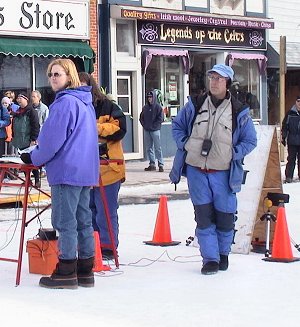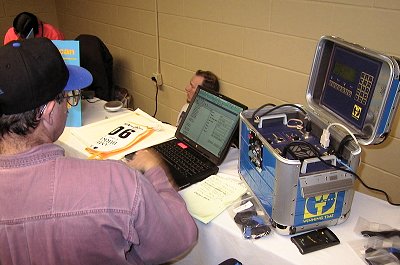Interview: Chuck Olson, White River Sports Timing
February 17, 2003
 White River Sports Timing, better known within the racing
community as "itiming", has become one of the premier
timing companies in the region. Chuck Olson, founder, was
one of the leaders in posting quick, high-quality results
on the Internet (almost always same-day). Last season, their
company brought the Birkie results into the 21st century,
utilizing a professional chip timing system.
White River Sports Timing, better known within the racing
community as "itiming", has become one of the premier
timing companies in the region. Chuck Olson, founder, was
one of the leaders in posting quick, high-quality results
on the Internet (almost always same-day). Last season, their
company brought the Birkie results into the 21st century,
utilizing a professional chip timing system.
We interviewed Olson by e-mail on Monday, February 17th.
- Skinnyski: White River Sports Timing -- how did the
name originate?
Olson: We reside in the Chequamegon National Forest on
the headwaters of the White River's East Fork--in a township
called Delta. Delta is where the White River's three forks
(East, West & South) originate and meet--hence the name,
Delta is appropriate--(think the triangular greek symbol
delta). We could have named it Delta Sports Timing--and
Delta is a lot closer to the beginning of the alphabet--but
there are a fair number of companies named Delta--so we
felt that White River would be unique. White River is
one of the things that drew us to this area--so it is
meaningful to us.
- Skinnyski: How many years have you been involved in
the timing business?
Olson: 13 years (since 1990). We began by timing high
school cross country ski events, branched into running,
and then into cycling, and multi-sport events. At first,
this seemed an unusual way to get started; but I found
this year that we are now competing with three other timers
who started the same way. Running events, being the most
common, are usually where timers get started.
- Skinnyski: When did you switch over to a chip timing
system?
Olson: Two years ago. Chip timing allows our staff the
ability to time larger events accurately and rapidly.
It also brings us the ability to time splits/laps/hill
climbs within races--which would not be possible with
hand timing. For example, before chip timing the Birkie
had two finish lines. The elite finishers were timed at
the race finish line; the other skier's times were taken
in a chute after the finish line. With many racers finishing,
racers would have to stand in line in the chute and not
get timed until their place in the chute line moved to
the front. So, situations arose, where some skiers would
get ahead or behind other skiers while standing in the
chute line waiting to get timed. Chip timing solved this
problem, since all skiers now get timed at the race finish
line. Chip timing also allows a split time to be taken--as
we did last year at the Birkie half-way point.

Another advantage to chip timing is that the chip scan
before the race catches registration errors. By fixing
incorrect ages, genders, and race entered info; preliminary
results can be more accurate than hand timing. So, when
we leave a race site; the results are already in essentially
final form and ready for internet posting. This speeds
the final results process substantially. A few years ago,
it might have taken a large event a week or two to get
the registration information updated and final results
posted.
- Skinnyski: How many chips do you have on hand, especially
for a big event like the Birkie?
Olson: The number of chips we keep on hand varies based
on our race schedule demands. We keep enough chips to
time most of our events. For our largest events, we draw
chips from Winning Time. Winning Time is a world-wide
company. This year we received 7000 chips for Birkie from
Winning Time USA. After Birkie, we will ship the Winning
Time chips to Winning Time timing companies in Denver
and Seattle. We have shipped them as far as New Zealand,
for Pop-Runner, also a Winning Time company.
- Skinnyski: What are some of the more common problems
you encounter with timing?
Olson: Most common problem is people not returning their
chips. These are usually people who pick up their race
packet and then decide not to race--or pick up a packet
for someone else--who does not attend.
Less common, but perhaps more related to your question:
Timing-wise, two issues are most common. The most common
problem is not wearing the chip. Second most common problem,
is wearing someone else's chip--either by mistake or by
a racer substituting themselves for an absent racer.
We do collect manual backup select times when possible,
so we can often get a time for a racer not wearing a chip--but
we can not guarantee this. The other problem causes results
problems; for example if a faster racer (or different
gender) wears the chip registered under a slower racer;
then results can be wrong. A typical result's problem
is a husband wearing a wife's chip or a boyfriend wearing
a girlfriend's chip.
- Skinnyski: Do the chips eventually wear out?
Olson: The chips used for timing citizen races are passive
chips--they do not have a battery. This makes them very
reliable and also inexpensive enough to issue them to
mass numbers of racers. The trade-off is that the timing
line antennae's have to be large to generate a strong
field to trigger the chips.
There are also powered chips, such as those used in
race cars and high level events, like the Giro, the Tour
de France and the Olympics. These chips are very expensive;
but since they are powered, the antennae's can shrink
to a small wire (and be buried in the race course).
The chips don't really wear out (they are encased in
either rigid or flexible plastic). Ours are worn on a
velcro strap around the ankle. Some chips will eventually
fail--due to physical damage (uncommon) or racer loss
(most common) or due to problems with the electronics
(very rare). We prescan every chip before each race to
ensure that all the chips we supply are functional.
- Skinnyski: Any other interesting stories from your
timing experience?
Olson: Fortunately, things have gone well with our chip
timing experiences. We received excellent training and
actual race-timing experience from Winning Time, USA in
Denver. We did have a spectator accidently pull a timing
wire at the swim finish of a triathlon. Luck was on our
side, as we were standing right beside the box and plugged
it back in before we had swimmers hitting the beach. We
also have manual timers available, should we need them.
I did hear about a large rowing/kayak/canoe event in
Great Britain, that was operating their timing equipment
on an event-supplied generator. The generator malfuntioned
(big-time) and fried $60,000 worth of timing equipment.
We could tell lots of stories from many road trips--but
they are road trip stories--not timing stories. For example,
we had a fellow from Greece somehow show up in Ashland
for the Whistlestop Marathon--he thought Ashland was a
large city, where it would be easy to find lodging. So,
when no lodging was available, we offered him lodging
in our timing RV so he did not have to sleep in the parking
lot.
I am sure there are many interesting stories; especially
about timers and sanctioning officials--perhaps better
left untold.
Related links
|



